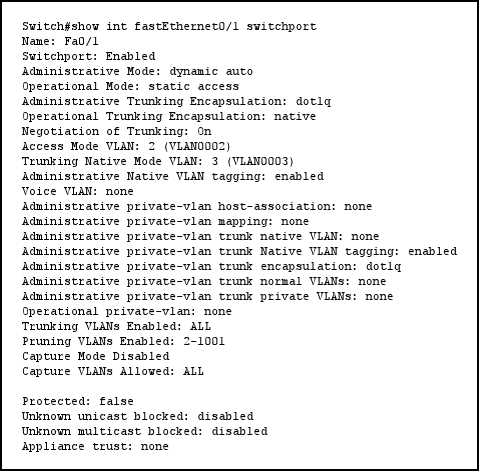READ Free Dumps For Cisco- 400-101
| Question ID 18594 | Refer to the exhibit.

If a port is configured as shown and receives an untagged frame, of which VLAN will the
untagged frame be a member?
|
| Option A | VLAN 1
|
| Option B | VLAN 2
|
| Option C | VLAN 3
|
| Option D | VLAN 4
|
| Correct Answer | B |
Explanation Explanation: When typing: Switch(config-if)#switchport mode? Set trunking mode to ACCESS unconditionally Set trunking mode to dynamically negotiate access or trunk mode Set trunking mode to TRUNK unconditionally and Switch(config-if)#switchport mode dynamic? Set trunking mode dynamic negotiation parameter to AUTO Set trunking mode dynamic negotiation parameter to DESIRABLE So if we configure Fa0/1 as dynamic auto mode, it will not initiate any negotitation but waiting for the other end negotiate to be a trunk with DTP. If the other end does not ask it to become a trunk then it will become an access port. Therefore when using the show interface fastEthernet0/1 switchport command we will see two output lines Administrative Mode. dynamic auto and Operational Mode. static access Note. To set this port to VLAN 2 as the output above just use one additional command. switchport access vlan 2. Now back to our question, from the output we see that Fa0/1 is operating as an access port on VLAN 2 so if it receive untagged frame it will suppose that frame is coming from VLAN 2.
| Question ID 18595 | Which two statements about Inverse ARP are true? (Choose two.)
|
| Option A | It uses the same operation code as ARP.
|
| Option B | It uses the same packet format as ARP.
|
| Option C | It uses ARP stuffing.
|
| Option D | It supports static mapping.
|
| Option E | It translates Layer 2 addresses to Layer 3 addresses.
|
| Option F | It translates Layer 3 addresses to Layer 2 addresses.
|
| Correct Answer | B,E |
Explanation Explanation: Inverse Address Resolution Protocol (Inverse ARP or InARP) is used to obtain Network Layer addresses (for example, IP addresses) of other nodes from Data Link Layer (Layer 2) addresses. It is primarily used in Frame Relay (DLCI) and ATM networks, in which Layer 2 addresses of virtual circuits are sometimes obtained from Layer 2 signaling, and the corresponding Layer 3 addresses must be available before those virtual circuits can be used. Since ARP translates Layer 3 addresses to Layer 2 addresses, InARP may be described as its inverse. In addition, InARP is implemented as a protocol extension to ARP: it uses the same packet format as ARP, but different operation codes. Reference: http://en.wikipedia.org/wiki/Address_Resolution_Protocol
